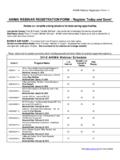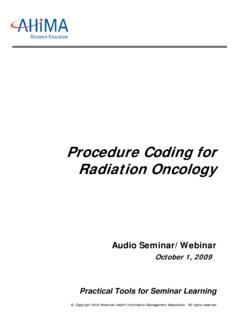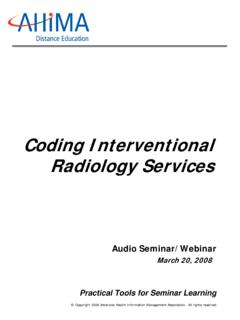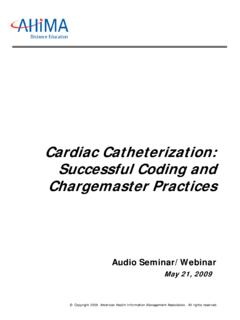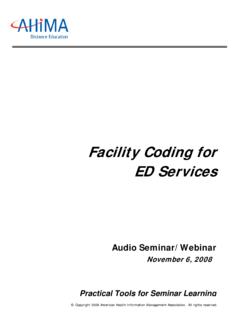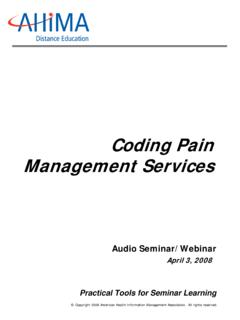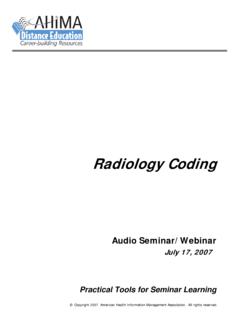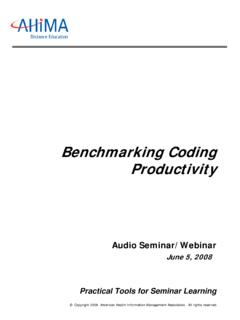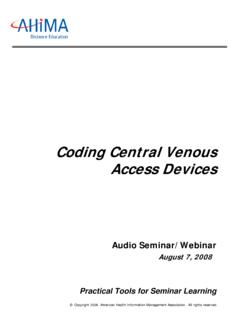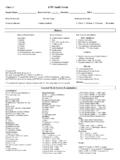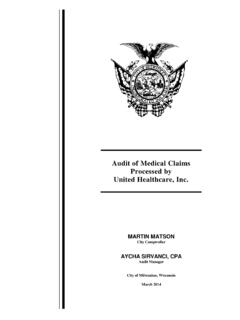Transcription of Performing a Chart Audit - American Health …
1 Copyright 2006 American Health Information Management Association. All rights reserved. Performing a Chart Audit Practical Tools for Seminar Learning Disclaimer i The American Health Information Management Association makes no representation or guarantee with respect to the contents herein and specifically disclaims any implied guarantee of suitability for any specific purpose. AHIMA has no liability or responsibility to any person or entity with respect to any loss or damage caused by the use of this audio seminar, including but not limited to any loss of revenue, interruption of service, loss of business, or indirect damages resulting from the use of this program.
2 AHIMA makes no guarantee that the use of this program will prevent differences of opinion or disputes with Medicare or other third party payers as to the amount that will be paid to providers of service. How to earn one (1) CEU for participation To earn one (1) continuing education unit, each participant must do the following: Step 1: Listen to the seminar, via Webcast link, audio CD, or MP3. Step 2: Complete the assessment quiz contained in this resource book. Use the included answer key. Do not return the quiz to AHIMA. Save it for your records. Step 3: Fax or mail us the completed sign-in form from this resource book. The fax number and address are located at the bottom of the form .
3 Step 4: Print the certificate of attendance for each listener. The certificate must be retained by each participant as a record of their participation, along with a copy of their completed quiz. After listening to the seminar, please let us know what you think, by completing our online evaluation survey at Faculty ii Susan M. Hull, MPH, RHIA, CCS, CCS-P Susan M. Hull, MPH, RHIA, CCS, CCS-P is a professional practice resources manager for the American Health Information Management Association (AHIMA). In her role as manager, Susan provides professional expertise to AHIMA members, the media, and outside organizations on coding practice issues, and develops written products aimed at furthering the art and science of coding.
4 Susan has over 20 years experience in the HIM field. Before joining AHIMA in 2002, she served as Senior Executive Director for HMI Corporation where she oversaw coding reviews; chargemaster maintenance and development; and presented seminars in outpatient, inpatient, and physician documentation and coding. Prior to this, she worked in numerous HIM roles, including consultant, HIM department director, and HIM software developer and manager. In addition to AHIMA, Susan is actively involved as a volunteer in the HIM profession. She has presented on timely HIM topics to the Health Information Management Associations of California, Tennessee, and Southern Illinois, as well as the Southern Illinois Healthcare Financial Management Association.
5 Susan received a bachelor of arts degree and a master of public Health in Health Services and Hospital Administration from the University of California, Los Angeles. Table of Contents Disclaimer ..i How to earn one (1) CEU for participation .. i Faculty ..ii Monitoring vs. 1 Reasons to perform Chart 1 Items to Audit ..2-3 How to select records .. 4 Causes of coding errors .. 4-5 E&M 5 Weighting 6 Frequency of Chart Audit .. 6 OIG compliance guidelines .. 7 OIG areas of 7-8 AHIMA Audio Seminars .. 8 About assessment quiz .. 9 Thank you for attending (with link for evaluation survey) .. 9 Appendix ..10 Assessment Quiz Continuing Education Credit and Compliance Sign-in form Certificate of Attendance and Quiz Completion Quiz Answer Key Performing a Chart Audit 1 Notes/CommentsMonitoring vs.
6 AuditMonitoringOngoing internal review of operations conducted by an organization on a regular basisAuditInfrequent, retrospective review, usually conducted by an outside agency to ensure objectivity1 Reasons to perform Chart audits To identify potential compliance pitfalls To assure that reimbursement is appropriate to services performed To determine if polices and procedures are current and appropriate 2 Performing a Chart Audit 2 Notes/CommentsItems to Audit Evaluation and management coding Physician Voluntary Reporting Program quality indicators Procedural coding Is code assignment supported by operative record? Are codes listed in the appropriate order? Consultation request/report rendered Appropriate modifier use ICD-9-CM coding accuracy and code linkage Documentation of medical Items to Audit Are entries legible?
7 Do dates of service match on record and claim form ? Is the patient identification present on each page of the record? Are entries dated and authenticated? Check payer guidelines for authentication (Continued) Performing a Chart Audit 3 Notes/CommentsItems to Audit Is the treatment plan documented and consistent with recorded diagnoses? Are special records required by payers present? Immunization records Developmental milestones Problem (Continued) Items to Audit Are the diagnoses documented within the visit record? superbill is not part of the record Is documentation consistent across all information sources ( , right vs. left)? If there are contradictions within the documentation, is it clear why?
8 (Continued)6 Performing a Chart Audit 4 Notes/CommentsHow to select records Random sample Internally identified problems Specific practitioners Specific diagnoses and/or procedures Specific time frame Specific payors Sample of cases that show significant variance from benchmarks Denied claims 7 Causes of coding errors Poor documentation Failure to review entire record Insufficient coder education Lack of coding knowledge/skills Lack of understanding of disease process Misinterpretation of coding rules/guidelines Lack of familiarity with NCCI Performing a Chart Audit 5 Notes/CommentsCauses of coding errors Poorly supported encoding software Inaccurate superbills Selection of
9 First listed diagnosis based upon reimbursement rather than documentation Inappropriate use of modifiers Lack of or outdated reference materials, including code books (Continued)9 E&M auditing May use either 1995 or 1997 guidelines May vary from patient to patient Must be consistent within each patient10 Performing a Chart Audit 6 Notes/CommentsWeighting errors Assign point value for each error Compliance issues (such as CPT code not supported by documentation in operative record) have a greater value than issues such as undated entries11 Frequency of Chart Audit OIG guidelines state at least yearly If problems identified, do more frequently If multiple practitioners, do more smaller audits12 Performing a Chart Audit 7 Notes/CommentsOIG compliance guidelinesOIG Compliance Program for Individual and Small Group Physician OIG areas of focus Billing for items or services not rendered or not provided as claimed Submitting claims for equipment.
10 Medical supplies and services that are not reasonable and necessary Double billing resulting in duplicate payment Billing for non-covered services as if Performing a Chart Audit 8 Notes/CommentsOIG areas of focus Knowing misuse of provider identification numbers, which results in improper billing Unbundling (billing for each component of the service instead of billing or using an all-inclusive code) Failure to properly use coding modifiers Clustering ( , coding only level 3 evaluation and management codes) Upcoding the level of service(Continued)15 AHIMA Audio SeminarsVisit our Web site updated information on the current seminar schedule. While online, you can also register for live seminars or order CDs and Webcasts of past seminars.
